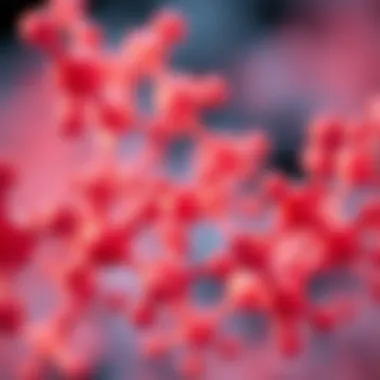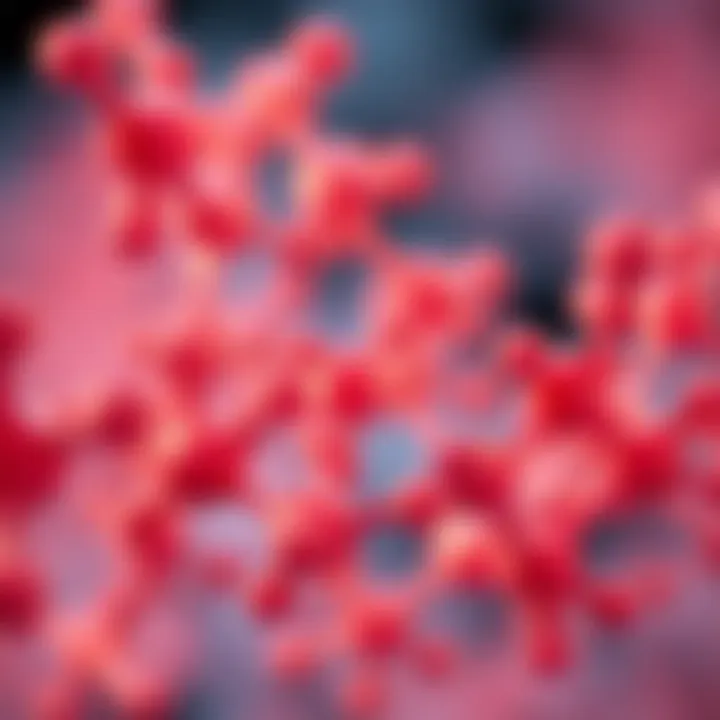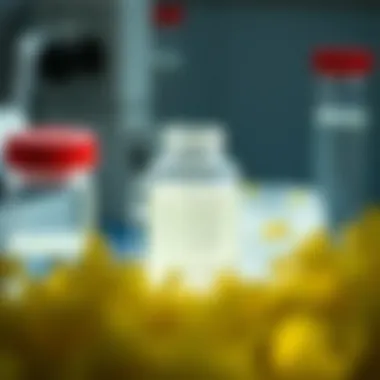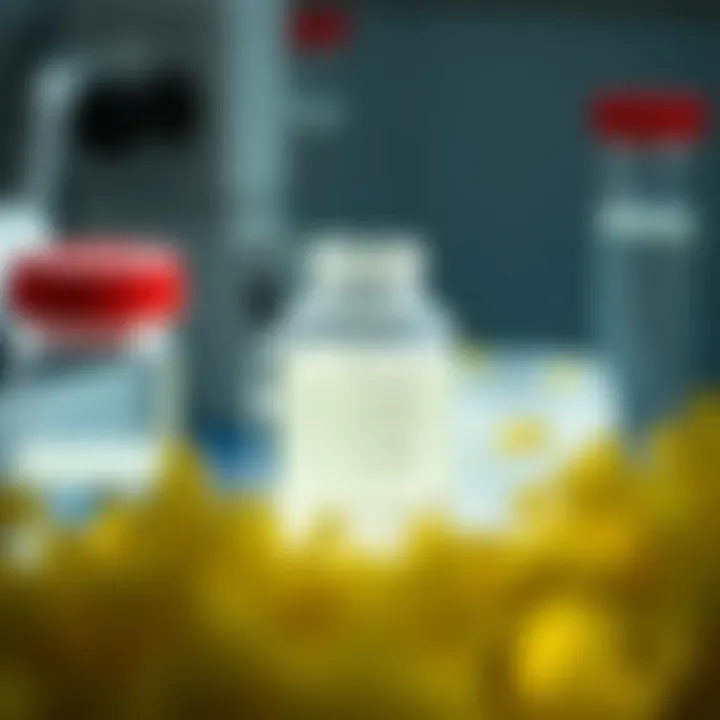S1 Nuclease Buffer: Composition and Applications


Intro
S1 nuclease buffer stands as a pivotal component in the realm of molecular biology, particularly known for its application in nucleic acid manipulation and analysis. Crafting a suitable environment for S1 nuclease is essential for its efficacy, and the composition of the buffer plays a vital role in this process. Understanding its specifics can lead to enhanced methodologies in various research fields, from cloning to the analysis of RNA and DNA abnormalities.
In the fast-evolving landscape of biochemistry, maintaining clarity while navigating complex concepts becomes critical. This article aims to delineate the intricate details surrounding S1 nuclease buffer, shedding light on its composition, technical applications, and essential methodologies. Readers—be they educators, researchers, students, or professionals—will find both breadth and depth in the ensuing exploration.
Through this lens, we will demystify not only the chemical components involved but also how these elements interact under different conditions, affecting the activity of S1 nuclease. The journey includes troubleshooting common issues-associated pitfalls users might encounter when working with these solutions. As we forge ahead, we'll endeavor to make the complexities of S1 nuclease and its buffer accessible to all, without diluting the sophistication inherent in the subject.
Let's embark on this deep dive into the overview of S1 nuclease buffer, illustrating its significance and practical utility in modern molecular biology.
Intro to S1 Nuclease Buffer
Understanding the complexities of biological processes often hinges on the tools and reagents employed in laboratory settings. One such crucial tool is the S1 nuclease buffer. This buffer is not merely a format; it serves as the backbone for numerous biochemical assays. When diving into molecular biology, the S1 nuclease buffer stands out due to its specific composition and function, tailored to enable precision in nucleic acid manipulation.
In essence, S1 nuclease is an enzyme that plays a pivotal role in the degradation of single-stranded nucleic acids. Thus, the S1 nuclease buffer not only ensures a conducive environment for this enzyme to operate but also significantly impacts the outcomes of experimental procedures. When working with nucleic acids, the appropriateness of the buffer can truly define the success or failure of an experiment.
Understanding Nucleases in Molecular Biology
Nucleases are enzymes essential for the hydrolysis of nucleic acids. They can be broadly categorized into two types: exonucleases and endonucleases. Exonucleases degrade nucleic acids from the ends, whereas endonucleases cleave internal phosphodiester bonds. S1 nuclease represents a type of endonuclease that is particularly adept at cleaving single-stranded DNA and RNA. This property is invaluable in various experimental frameworks, such as in the design of probes for hybridization assays or during the analysis of nucleic acid fragments produced through various treatments.
In practical applications, the activity of S1 nuclease is tremendously useful for tasks like constructing cDNA libraries or in the DNA recombination process. Without the proper buffer, however, the efficacy of the S1 nuclease could be compromised, leading to inconclusive results or invalid data.
The Role of Buffers in Enzymatic Reactions
In enzymatic reactions, the buffer serves multiple roles, essentially acting as a safeguard. It maintains the pH at desired levels, provides essential ions, and ensures optimal conditions for the enzyme’s activity. For S1 nuclease, the buffer composition is tailored to fulfill specific ionic and pH requirements that can enhance or inhibit its catalytic effectiveness.
The S1 nuclease buffer typically contains a combination of sodium acetate, tris-HCl, and EDTA, each playing distinct roles. Sodium acetate adjusts the ionic strength and helps stabilize the enzyme’s environment. Tris-HCl offers a buffering capacity within a physiological pH range, crucial for maintaining consistency during experiments. Lastly, EDTA acts as a chelating agent, sequestering divalent metal ions that might otherwise interfere with enzyme activity.
In sum, a clear comprehension of the S1 nuclease buffer is essential for any researcher venturing into the realms of molecular biology. Its proper use lays the groundwork for countless applications, facilitating the exploration of nucleic acids and their myriad functions.
Composition of S1 Nuclease Buffer
The composition of S1 nuclease buffer is not just a list of ingredients; it's a carefully curated selection that enables various enzymatic reactions to flourish. Understanding the components that make up this buffer not only illustrates its functionality but also highlights why certain elements are favored in the molecular biology toolbox. Each component plays a crucial role, and the nuances of their interactions can greatly influence experimental outcomes.
By delving into the specific constituents, one can appreciate their individual contributions and why they are integral to the performance of S1 nuclease. This understanding informs the preparation process while ensuring optimal conditions for the enzyme's activity, thus making it imperative to have a good grasp on the buffer's composition.
Key Components Explained
Sodium Acetate
Sodium acetate is a commonly used component in the S1 nuclease buffer due to its buffering capabilities. This salt serves a dual purpose: it not only maintains a stable pH during reactions but also enhances nucleic acid stability, which is crucial in various assays. Its ability to effectively maintain an alkaline environment makes it a reliable choice.
Key Characteristic: Sodium acetate’s inherent qualities include its low toxicity and adaptability to various experimental conditions.
Why It's Beneficial: Its buffering capacity allows for consistent enzymatic activity. If the pH shifts too far from the enzyme's optimal range, the S1 nuclease could become inactive.
Unique Features: One major advantage is that sodium acetate can easily dissolve in water, making it straightforward to incorporate into buffer solutions. However, excessive concentrations can lead to precipitation, which may complicate protocols.
Tris-HCl
Tris-HCl, short for tris(hydroxymethyl)aminomethane hydrochloride, is another key player in the world of buffers used in molecular biology. It’s prized for its capacity to resist pH changes—an invaluable trait when working with sensitive reactions.
Key Characteristic: One of its known strengths lies in its ability to remain effective across a wide temperature range, making Tris-HCl versatile for many applications.
Why It's Beneficial: This buffer is particularly well-suited for reactions involving nucleic acids, as it minimizes the potential for substrate degradation that often stems from pH fluctuations.
Unique Features: Tris-HCl is often favored for its bio-compatibility, meaning it supports the natural environment that many enzymes, including S1 nuclease, depend on. However, it’s worth noting that it can interfere in some assays when high ionic strength is present.
EDTA


Ethylenediaminetetraacetic acid (EDTA) is another critical ingredient often found within S1 nuclease buffers. Its primary function is to chelate divalent cations such as Mg²⁺ and Ca²⁺, which can be detrimental in certain enzymatic reactions.
Key Characteristic: Its chelating ability helps preserve the integrity of nucleic acids by preventing unwanted degradation.
Why It's Beneficial: By sequestering these ions, EDTA effectively inhibits the activity of nucleases that require these cations for their function, ensuring that the S1 nuclease can perform its job without interference from other nucleases.
Unique Features: EDTA is quite effective at low concentrations, which is advantageous since high levels could potentially affect the activity of S1 nuclease itself due to its complexing properties. Striking the right balance is essential.
Concentration Ranges and Their Significance
The concentration of each component in the S1 nuclease buffer can significantly impact the buffer's efficacy and the overall results of an experiment. Too low a concentration may not provide sufficient buffering capacity, while too high can lead to interference and toxicity.
"Finding the sweet spot in concentration ranges is vital for achieving optimal enzymatic activity."
Experimenters must reference specific protocols and guidelines to establish the right concentrations tailored to their specific applications. Commonly, sodium acetate concentrations range from 10 to 50 mM, while Tris-HCl concentrations may be kept around 10 to 50 mM, varying based on the specific requirements of the reaction.
Optimizing these concentrations ensures that conditions are favorable for S1 nuclease activity and enhances the reliability of results derived from its application. Through meticulous adjustment of these components, researchers can tailor their buffering conditions to their specific needs, thereby improving reproducibility in their experiments.
Applications of S1 Nuclease Buffer
S1 nuclease buffer plays a pivotal role in a variety of biochemical applications, serving as a foundation for numerous molecular biology techniques. Its importance lies not only in its capacity to support enzymatic reactions but also in how it enhances the efficacy and reliability of results across a wide spectrum of experiments. For students and professionals alike, understanding the intricacies of S1 nuclease buffer applications is crucial. Significant elements include nucleic acid fragmentation studies and their use in hybridization reactions, both of which are critical in genetic research and diagnostics.
Nucleic Acid Fragmentation Studies
Fragmentation of nucleic acids is a key technique in molecular biology, especially when dissecting the complex structures of DNA and RNA. S1 nuclease specifically targets single-stranded regions, making it an invaluable tool in studies involving nucleic acid degradation. The enzyme cleaves DNA or RNA to generate smaller fragments, which are often essential for subsequent analyses.
- Applications:
- Genomic Library Construction: In creating genomic libraries, fragmentation is necessary to ensure that the DNA pieces are of optimal size for cloning into vectors.
- Next Generation Sequencing: Proper fragmentation can improve the efficiency and accuracy of sequencing results, creating shorter reads that are easier to analyze when amplified.
To underscore this capacity, consider the practical example when researchers use S1 nuclease buffer to assess DNA integrity post-treatment with various agents. By employing gel electrophoresis, scientists can visualize the clear bands of fragmented nucleic acids, signaling the effectiveness of their methodologies. The precision of nucleic acid fragmentation facilitated by S1 nuclease provides a strong basis for reliable results in numerous experimental designs.
Use in Hybridization Reactions
S1 nuclease buffer's role extends into the realm of hybridization reactions, particularly when studying complementary nucleic acid sequences. Hybridization—where single strands come together to form double-stranded structures—requires specific conditions often catered to by S1 nuclease buffer.
- Benefits:
- Stability: It offers a stable environment that can sustain hybrids long enough for detection and analysis.
- Specificity: The buffer aids in reducing non-specific bindings, enhancing the specificity of the hybridization process.
In practical terms, researchers use S1 nuclease during probe hybridization in fluorescence in situ hybridization (FISH) protocols. Here, the buffer conditions are fine-tuned to prevent background noise, allowing for clearer visualization of target sequences. It is paramount for correct interpretations of gene expressions, mutations, and other critical findings within cellular samples.
"The delicate balance of pH, ionic strength, and temperature provided by S1 nuclease buffer is essential in achieving meaningful outcomes in hybridization reactions."
In summary, the applications of S1 nuclease buffer are diverse, encompassing nucleic acid fragmentation and hybridization reactions. Both approaches benefit from the properties of the buffer, enhancing the precision and success rates in experiments, making it a staple in the toolkit of molecular biology professionals. As research continues to advance, the reliance on such buffers remains instrumental in pushing the boundaries of genetic and biochemical discoveries.
Mechanism of Action of S1 Nuclease
Understanding the mechanism by which S1 nuclease operates is crucial for appreciating its role in various biochemical applications. This enzyme, known for its ability to cleave single-stranded DNA and RNA, becomes a powerful tool in molecular biology. The action of S1 nuclease isn’t just about the enzyme itself; it also heavily relies on the specific conditions of the buffer it operates in. The interplay of these elements can significantly influence experimental outcomes.
S1 Nuclease Activity: Catalytic Mechanism
The catalytic mechanism of S1 nuclease revolves around its ability to hydrolyze the phosphate backbone of nucleic acids. This means that it can effectively cut through phosphodiester bonds, which are the structural links between nucleotides in RNA and single-stranded DNA. The enzyme acts on free ends and is particularly efficient in recognizing and processing nucleic acids that are distorted or otherwise destabilized.
Within the active site of S1 nuclease lies a sophisticated arrangement of amino acids that facilitate this hydrolysis process, generally requiring water as a co-substrate. The interactions at the molecular level set the stage for this enzyme to selectively target certain substrates over others, making it invaluable for applications such as probing RNA secondary structures or assessing the integrity of nucleic acids. Understanding this mechanism provides insights into how to optimize conditions for expected efficiencies in molecular experiments.
Factors Influencing Activity
Temperature


Temperature is one of those fickle factors that scientists must manage carefully. It plays a significant role in enzyme kinetics, essentially dictating how fast or slow enzymatic reactions proceed. S1 nuclease usually operates best within a certain temperature range, typically around room temperature to 37 degrees Celsius. This range is a sweet spot, as it enables optimal activity while minimizing protein denaturation. If the temperature strays too far outside this range, the enzyme can either become sluggish or completely inactive. This characteristic of temperature is a beneficial choice because maintaining it within the ideal range ensures consistent results, particularly in enzyme assays or nucleic acid manipulations.
pH Levels
When it comes to pH levels, this factor essentially provides the environment in which S1 nuclease can thrive. For optimal activity, a pH between 7 and 8 is generally desirable. This neutral to slightly alkaline range not only stabilizes the enzyme but also maintains the integrity of the nucleic acids involved in the reaction. Deviating from this range can lead to reduced S1 nuclease functionality. A unique aspect of pH is the way it can change the ionization states of both the enzyme and substrate, influencing reaction rates. The consistent performance in the preferred pH range makes it a popular choice in various research settings, minimizing complications that could arise from suboptimal conditions.
Ionic Strength
Ionic strength is another player in the unfolding story of S1 nuclease activity. By affecting the electrostatic interactions between the enzyme and its substrate, ionic strength can influence the binding affinity. A moderate ionic strength, often achieved with buffers like sodium acetate, helps stabilize the enzyme's structure and optimize its interaction with nucleic acids. Too low of an ionic strength may weaken these interactions, while too high a concentration of salts can lead to unspecific binding or precipitation of nucleic acids. Finding that middle ground is crucial, as it can enhance the overall efficiency of reactions involving S1 nuclease, making it invaluable for molecular biology applications.
"The effectiveness of S1 nuclease is contingent upon the careful calibration of experimental conditions, ensuring optimal activity and reproducibility."
In summary, the mechanism of action of S1 nuclease is intricately tied to environmental factors like temperature, pH levels, and ionic strength. These components not only define the enzyme's performance but also dictate the efficiency of various molecular biology protocols. Understanding and managing these factors is key to successful applications involving S1 nuclease.
Preparation of S1 Nuclease Buffer
The preparation of S1 nuclease buffer is a pivotal process in molecular biology, a field where precision can’t be overstated. Buffers play a critical role in maintaining the optimal environment for enzymatic reactions, ensuring that the conditions are just right for S1 nuclease to perform efficiently. Whether you’re breaking down nucleic acids or setting the stage for hybridization reactions, understanding how to prepare this buffer meticulously shapes your experiments' success.
Properly prepared, this buffer helps create a milieu where the S1 nuclease can cleave single-stranded nucleic acids without a hitch. Get it wrong, and you may encounter myriad problems, such as low enzymatic activity or unanticipated results. Familiarizing oneself with the preparation steps is thus integral for both novice and seasoned researchers.
Step-by-Step Preparation Protocol
The process for preparing S1 nuclease buffer might seem straightforward if you’ve done it before, but it's worth emphasizing the importance of accuracy and the right techniques. Here’s a step-by-step guide to ensure you’re doing it right:
- Gather Materials: Before starting, make sure you have all necessary reagents. Common components include Sodium Acetate, Tris-HCl, and EDTA.
- Dilution: Prepare a stock solution of each component. For instance, Sodium Acetate is often best at a concentration of about 0.1M.
- Mixing: In a clean container, slowly add the Sodium Acetate to distilled water, followed by Tris-HCl and EDTA, mixing gently to ensure full dissolution of each component.
- pH Adjustment: Using pH paper or a pH meter, check whether the buffer is at the desired pH. Adjust if necessary, typically aiming for a pH around 7.5 to 8.0.
- Final Volume: Add distilled water until the buffer reaches your required final volume, ensuring thorough mixing throughout.
- Sterilization: If the protocol allows, sterilizing the buffer by passing it through a 0.22 µm filter can help eliminate contaminants that might interfere with nucleic acid reactions.
Following these steps precisely reduces the chances of running into trouble during experiments.
Storage Conditions and Shelf Life
Now that you have this bustling buffer ready to go, the question of how to store it comes into play. Proper storage conditions are significant in prolonging the shelf life of your S1 nuclease buffer. Here are some guidelines:
- Temperature: Store the buffer at 4°C for short-term usage, especially if you plan to use it within a month or two. For long-term storage, freezing at -20°C can help preserve its integrity.
- Avoid Light: Keep the buffer in opaque containers, if possible. Light can degrade certain buffer components, impacting their functionality over time.
- Monitor Shelf Life: Generally, an prepared S1 nuclease buffer can last several months if stored correctly. However, checking for changes in color or precipitate formation is wise. If anything looks off, it’s best to prepare a new batch.
- Labeling: Clearly label your buffer solutions with the date of preparation. This simple act can save you from using old solutions unknowingly.
"A little attention to detail goes a long way in ensuring reliable results in your experiments."
In sum, understanding the preparation and storage procedures for S1 nuclease buffer enhances the reliability of the various applications it supports, all while giving a fresh researcher the confidence they need to delve into their work.
Troubleshooting Common Issues
When working with S1 nuclease buffer, it is crucial to anticipate and address potential troubleshooting issues. This section sheds light on common complications that may arise during experiments and emphasizes the significance of understanding these challenges to enhance experimental outcomes. Monitoring the nuances of buffer interactions and enzyme activity can prevent minor hitches from escalating into major setbacks, ultimately saving time and resources.
Identification of Inhibition Factors
Identifying factors that may inhibit the activity of S1 nuclease is fundamental to ensuring successful reactions. At this point, it helps to consider several key elements:
- Presence of Inhibitors: Certain substances, such as phenol or certain detergents, can negatively affect nuclease activity. Being aware of contaminants in your sample is essential. It's prudent to conduct a thorough analysis of your reagents.
- Substrate Quality: The integrity of nucleic acids is important. Degraded samples can lead to inaccurate results. Running a gel electrophoresis can help assess the quality of your nucleic acids before adding the nuclease.
- Buffer Concentrations: High salt concentrations or extreme pH levels can severely inhibit S1 nuclease activity. Keeping track of your buffer's composition is paramount to avoid any potential pitfalls.
"Understanding the roots of inhibition not only leads to better results but also sharpens one’s analytical skills in molecular biology."
The process of identifying inhibition factors entails testing different conditions and analyzing the results carefully. A systematic approach allows researchers to pinpoint the exact reasons for any issues encountered.
Adjusting Buffer Conditions for Optimal Outcomes
Once the inhibitors are identified, the next logical step is to adjust the buffer conditions. Here are some strategies for tweaking buffer parameters:
- Fine-Tuning Ionic Strength: Consider modifying the ionic strength by varying salt concentrations. Sometimes a simple dilution of the buffer can work wonders, releasing the enzymes from inhibition.
- pH Adjustments: Within the optimal range of pH, the functionality of S1 nuclease improves significantly. A quick check with a pH meter may indicate if adjustments are needed. Buffers like Tris-HCl can be used for adjustments.
- Temperature Control: Maintaining the right temperature during incubation can enhance enzyme stability and activity. If enzyme performance appears subdued, consider optimizing the incubation conditions.
- Contaminant Removal: If inhibitors are spotted, a purification method should be employed. Techniques like phenol-chloroform extraction or ethanol precipitation may be applied to clean up samples and thus increase the performance of the nuclease.
Success lies in diligence and patience. Each experiment provides invaluable lessons on the delicate balance required in enzymatic reactions. Adjustments must be made cautiously, ensuring that all alterations are documented to trace what works and what doesn't in future experiments.


The art of troubleshooting in nucleic acid work is no small feat, but refining these skills is key to mastering molecular biology assays. By anticipating issues and knowing how to respond, researchers can conduct more reliable results, pushing their projects towards success.
Comparative Analysis with Other Buffers
The comparative analysis of S1 nuclease buffer against other buffers plays a radiant role in molecular biology, as it provides insights into how varying buffer compositions can affect enzymatic reactions and the overall efficacy of biochemical assays. Understanding these differences is essential for optimizing conditions tailored specifically for experiments, ensuring reproducibility and accuracy in results.
S1 Nuclease Buffer vs. DNase Buffer
When it comes to the S1 nuclease buffer and its comparable counterpart, the DNase buffer, there are several facets that one needs to consider.
- Enzyme Specificity: S1 nuclease, primarily targeting single-stranded DNA and RNA, excels in applications involving nucleic acid degradation where specificity is essential. In contrast, DNase targets double-stranded DNA with a broader range. Depending on your need, selecting between these buffers influences the success of your assays.
- Buffer Composition: The S1 nuclease buffer is typically rich in sodium acetate and Tris-HCl, enabling stability and activity under various conditions. Meanwhile, DNase buffers often include magnesium ions, which are crucial for DNase activity but can inhibit S1 nuclease, highlighting the necessity of knowing your enzyme’s requirements while designing experiments.
- Optimized Conditions: The temperature and pH levels for S1 nuclease activity are often different from those needed for DNases. S1 nucleases tend to work well in slightly acidic to neutral conditions, whereas DNases might require more alkaline conditions. This nuanced understanding of buffer profiles can lead to significant improvements in experimental outcomes.
In summary, both buffers have unique advantages tailored to different enzymatic functions. The decision to use one over the other hinges on the specific requirements of your experimental goals.
Buffer Pairings for Enhanced Results
To capitalize on the distinctive properties of S1 nuclease buffer, combining it with other buffers can be a game-changer. Here are some strategic pairings for enhanced results:
- S1 Nuclease Buffer + Tris-EDTA (TE) Buffer: Combining these buffers can stabilize nucleic acids while maintaining the activity of S1 nuclease, particularly in short-term storage or reactions.
- S1 Nuclease Buffer + PBS (Phosphate Buffered Saline): Using PBS alongside can improve ionic strength and buffer capacity, enabling better performance in complex assays.
- S1 Nuclease Buffer + Phosphate Buffer: These buffers, when paired, can provide a robust environment for nucleic acid manipulation, maintaining the stability of reactants without compromising S1's activity.
By choosing optimal buffer combinations, one can enhance enzymatic efficiency and accuracy in molecular assays significantly.
These pairings can not only extend the functional reach of S1 nuclease buffer but can also create more favorable environments for nucleic acid processes, thereby enhancing the reliability of experimental results. Understanding the interactions between different buffers can be a foundational step towards greater innovation in biochemical research.
Future Perspectives in Nuclease Research
As we look ahead in the realm of molecular biology, the significance of advancements in nuclease research becomes ever more apparent. This space, particularly the exploration of S1 nuclease buffer, provides a fertile ground for innovation and development. With the ongoing evolution of methodologies, understanding how these buffers can be tailored for specific applications becomes critical. The benefits may not only enhance existing techniques but also pave the way for entirely new avenues of inquiry.
Innovations in Buffer Formulations
In recent years, researchers have focused on refining buffer compositions to optimize the operational efficiency of nucleases like S1. These innovations can fundamentally change how we approach nucleic acid manipulation. One exciting development is the incorporation of advanced buffering agents that maintain pH more consistently across varying temperatures. These formulations could assist in stabilizing enzyme activity during experiments, yielding more reproducible results and reducing the potential for variability.
Moreover, the trend of integrating additives that can enhance nuclease specificity is emerging. For instance, some studies indicate that the addition of certain polyethylene glycol (PEG) compounds can modulate the binding affinity of nucleases for specific substrates, effectively fine-tuning the reaction dynamics. This specificity can be crucial in applications such as gene editing, where precision is paramount.
- Potential Innovations Include:
- Development of temperature-resistant buffers for high-throughput applications.
- Tailoring buffers to support multi-nuclease activity without interference.
Being mindful of these innovations, researchers should take a proactive stance on adopting these advanced formulations. Implementing them might require some initial changes to established protocols, yet the potential payoffs may well compensate for the effort required.
Applications in Emerging Biotechnologies
Emerging biotechnological applications are another facet where S1 nuclease research is picking up steam. In the age of synthetic biology, tools that facilitate precise control over nucleic acids are more crucial than ever. S1 nuclease's ability to selectively degrade single-stranded nucleic acids positions it as an essential instrument in the toolkit of modern biotechnologists.
One notable application is in the realm of CRISPR technology, specifically in improving guide RNA maturation processes. By utilizing S1 nuclease buffer in these systems, scientists can enhance the efficiency of the RNA processing steps, leading to more effective gene knockout outcomes. This is vital for advancing therapeutic strategies targeting genetic disorders.
Additionally, there's a burgeoning interest in leveraging S1 nuclease and its buffer in the development of novel biosensors. These biosensors rely on the degradation capabilities of nucleases to report on the presence of specific nucleic acids within clinical samples. This potential for real-time monitoring of infectious agents or biomarkers could drastically alter disease management protocols.
In sum, the intersection of S1 nuclease research and biotechnology is not merely a point of interest but a promising frontier that holds transformative possibilities for both practical applications and academic inquiry.
The future of nuclease research hinges on embracing innovative buffer formulations and recognizing their applications in cutting-edge biotechnologies.
Closure
In this exploration of S1 nuclease buffer, we underscore its multifaceted significance within molecular biology. The buffer isn’t just a passive bystander; it's an active player in the enzymatic reactions pivotal to nucleic acid research. Understanding its composition and functionality is crucial for anyone involved in related fields. A solid grasp of S1 nuclease buffer can lead to more precise experimental outcomes, enhancing the reliability of scientific data.
Summing Up the Importance of S1 Nuclease Buffer
S1 nuclease buffer is indispensable for several reasons:
- Enzyme Activation: The buffer creates an optimal environment that activates S1 nuclease, allowing it to function efficiently. The right pH and ionic strength are critical here.
- Versatile Applications: It finds use across various applications, from nucleic acid fragmentation studies to hybridization reactions, confirming its versatility in research.
- Facilitating Discoveries: As researchers continue to unravel the genetic blueprints of life, the use of S1 nuclease buffer can lead to breakthroughs in understanding diseases and developing therapies.
Choosing the right buffer, including factors like storage and preparation, directly impacts experimental success.
A well-prepared S1 nuclease buffer is more than a simple solution; it is the backbone of reliable nucleic acid manipulation and often stands between scientific breakthroughs and failures.
For those diving deep into molecular biology, the S1 nuclease buffer represents not just a tool, but a crucial cog in the machinery that drives biochemical analysis and discovery. It’s clear that its role is as pivotal as it is profound in shaping our understanding of genetics.







